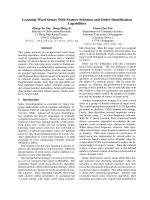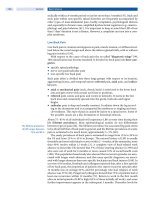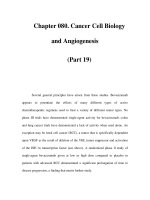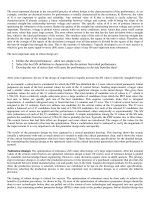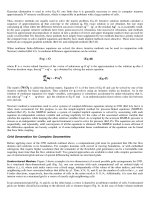19 hypertrophy training exercise selection and order part II
Bạn đang xem bản rút gọn của tài liệu. Xem và tải ngay bản đầy đủ của tài liệu tại đây (453.25 KB, 11 trang )
UNIVERSITY
Hypertrophy
Training
Exercise Selection, Order
and Execution Part II
The Lesson
PART I
Managing the stimulus to fatigue ratio
Ensuring you train the target muscle
Matching the movement to your abilities
Why bracing, stabilizing, and control are important factors
Matching Strength and Resistance Profiles
PART II
Multi joint vs single joint lifts pros and cons
Session and weekly exercise order planning
Exercise variation planning
Lift execution (tempo, mind muscle connection, rest times)
Multi Joint vs Single Joint lifts
Compounds (multi-joint)
Accumulate volume/stimulus over several muscle groups
Great for load progressions
Less precise stimulus
Greater systemic fatigue
Greater learning curve
Should be the core of your program and progressed over long term
Select based on area for emphasis
Isolations (single-joint)
Focus stimulus direct on target muscle
Less systemic fatigue
Less overall growth potential
Better for rep and set progressions
Less learning required
Select based on area for emphasis
Within Session Exercise Order
Multi-joint Lifts First
Output and Performance is highest importance to maximize stimulus
Begin with multi joint movements that are most demanding/technical and
secondarily focus on your weaknesses in development.
Free weight multi joint>>> machine work multi joint>>> single joint work
DB press >> machine chest press >>> pec deck fly
Single joint lifts first or last?
Pre-fatigue:
• Create local fatigue but also central fatigue limiting subsequent lifts
• May limit stimulating reps when the target muscle is already the prime
mover in the multi joint lift (ie leg extension before Leg press)
Utilize more as low fatigue activation or warm up sets
If a multi joint lift doesn’t target the intended muscle pre-fatigue is NOT the
answer, select a better multi-joint lift
Application if body part is very weak and will not effect multi-joint lifts for the
day
Within Session Exercise Order
Agonist vs Antagonist Pairing
Above all prioritize loading and weakness first
Rotate exercise that uphold this concept
Upper day example:
Upper day: Push, push, pull pull
Or
Upper day: push, pull, push, pull
Or
Upper day: pull, pull, push, push
Program off your needs!
Weekly Exercise Order
Localized Fatigue and Stimulus
Training a muscle 2-3x per week can cause overlap and recovery issues
Example: Deadlift on pull day fatiguing erectors for Squatting on leg
day
Solution: Deadlift on pull day, then leg press on leg day
Systemic Fatigue and stimulus
High volume, high effort session with generate large recovery debts
and CNS fatigue
Program lower volume, lower effort session between harder sessions
Simple questions to ask:
1. Is the target muscle of the day weaker?
2. Is the target muscle still very sore?
3. Is your fatigue level high?
Exercise Variety
Too much variety
Unfamiliar movements less productive for hypertrophy
Less skill acquisition
Harder to track progression
Too Little variety
Repetitive movement injuries
Decreased strength outcomes
Lack full muscle development
Enjoyment
Some variety
Improved strength outcomes
Improved uniform hypertrophy
Decreased repetitive movement injuries
Progressing lifts Is priority
Keep multi joint lifts the same if they progressing
Rotate single joint lifts more often if desired
Workout A, B, C rotations effective for advanced lifters needing more time
between workouts for overload
Execution for the Most Stimulus
Mind muscle connection
Internal cueing great for learning proper movement pattern
Improved antagonist and synergist muscle for improved stability and
control
External movement may look correct, but internal compensation can
occur
Simple application, do you “feel” the target muscle
Weak body parts look for compensation in movement
More potential for beginners than advanced lifters, limits on progressive
overload
Lifting Tempo
Controlled eccentric (2-3 seconds)
• Slow eccentrics increase time under tension, but require less load and volume
(opposite of what we want)
• Requires less energy and less force to lower a weight (lengthen)
Isometric (0-1 seconds) consider safety, no pause is best
Controlled Concentric (1-2 seconds)
• Requires more energy, and more force development
Execution for the Most Stimulus
Rest between reps
Slows down rate of fatigue and prolongs set duration
No rest decreases blood oxygen and less reps performed
Rest “enough” to not limit performance from cardiovascular capacity and
not too much to excessively prolong the set
Rest “enough” to gain control of the lift
Rest between sets
Shorter rest vs longer rest less productive for hypertrophy
Greater localized and CNS fatigue present to allow the next set to be as
stimulating (decrease in motor unit recruitment) allowing for fewer
stimulating reps.
Rest periods of 2-3 minutes between sets ideal, return of baseline heart
rate and breathing pattern
Master the Straight set first
Rest pause, drops sets, set extenders application for time efficiency and
single joint exercises and machine compound lifts
• Will likely require more sets to be performed as each subsequent set
less effective and less stimulating reps
Remember Hierarchy in Programming
Adherence Sustainability
Volume, intensity frequency
Exercise Execution Selection Order
LET’S LOOK AT SAMPLE LAY OUTS
Summary
PART II
Multi joint lifts are main lifts for load progression and should make up
core of program
Single joint lifts will compliment physique needs and add volume with less
fatigue
Tempo based around controlling tension is ideal (i.e. 2-0-2)
Rest between sets to regain cardiorespiratory capacity and not be limited
by fatigue (2-3 minutes)
Short rest times are time efficient by less stimulating for hypertrophy
Exercise order based on keeping out put high for target muscles per
session and planning weekly training based around overlap in stimulus
and fatigue
Program with enough variation to allow full development of all
musculature thorough different movement planes and joint actions and
allow tracking of progression.

